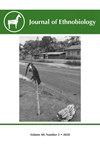熔岩流上的古代农业:利用激光雷达和土壤科学重新评估墨西哥西部马尔帕斯地貌上的前西班牙裔农业
IF 1.3
3区 社会学
Q1 ANTHROPOLOGY
引用次数: 3
摘要
摘要自前西班牙裔时代以来,墨西哥中央高地一直是人类定居的主要聚集地,其土壤为现代墨西哥提供了大部分食物。雨水灌溉种植生产了大部分农产品,现在仍然生产。然而,与其他做法相比,西班牙裔以前的雨养栽培记录较少。此外,文本和人种学记录,大多是在西班牙征服者所做的深刻修改之后,长期以来在对前西班牙裔农业的研究中普遍存在,并倾向于使我们对后者的概念产生偏见。考古学提供了新的关键信息,但很难解决雨水灌溉技术,这在一些景观中几乎没有留下什么遗迹。在这方面,考虑到地质生态参数的空间方法是有益的。此外,遥感技术和机载激光扫描(LiDAR)最重要的是,为特征检测提供了越来越大的潜力,并为在考古和环境层面处理化石景观提供了新的方法。本文通过跨学科的方法对西班牙裔以前的雨养栽培提供了新的见解。它专注于墨西哥西部萨卡普马尔帕斯地貌(年轻崎岖的熔岩流)上的考古定居点。在那里,开发了一种将考古和土壤科学中的实地调查和遥感相结合的方法来重新评估西班牙裔以前的农业。在介绍了该方法和本研究的主要结果后,我结合马尔帕斯地貌的民族历史和民族志使用的例子来讨论后者。他们认为,外部观察者对墨西哥中央高地农业土壤的广泛看法与土著和当地农民的看法不同,后者似乎部分继承自前西班牙裔时代。本文章由计算机程序翻译,如有差异,请以英文原文为准。
Ancient Agriculture on Lava Flows: Using LiDAR and Soil Science to Reassess Pre-Hispanic Farming on Malpaís Landforms in West Mexico
Abstract. The Mexican Central Highlands have been a major cluster for human settlement since pre-Hispanic times and its soils provide much of the food for modern Mexico. Rainfed cultivation yielded and still yields most of the agricultural products. However, pre-Hispanic rainfed cultivation has been less documented than other practices. Moreover, textual and ethnographic records, mostly postdating the deep modifications made by the Spanish conquerors, have long been prevalent in studies on pre-Hispanic farming and have tended to bias our conception of the latter. Archaeology provides new key information but struggles to address rainfed techniques, which leave few remains behind in some landscapes. To that regard, spatial approaches considering geoecological parameters are helpful. Furthermore, remote sensing techniques and airborne laser scanning (LiDAR), above all, offer increasing potential for feature detection and provides new ways to address fossilized landscapes at both archaeological and environmental levels. This paper offers new insights on pre-Hispanic rainfed cultivation through an interdisciplinary approach. It focuses on archaeological settlements on malpaís landforms (young and rugged lava flows) in the Malpaís de Zacapu, in western Mexico. There, a method combining fieldwork and remote sensing in archaeology and soil science was developed to reassess pre-Hispanic farming. After presenting the method and this study's main results, I discuss the latter in light of examples of ethnohistorical and ethnographical uses of malpaís landforms. They suggest that widespread conceptions about agricultural soils of the Mexican Central Highlands held by external observers differ from Indigenous and local farmers' notions, which seem partly inherited from pre-Hispanic times.
求助全文
通过发布文献求助,成功后即可免费获取论文全文。
去求助
来源期刊

Journal of Ethnobiology
Social Sciences-Anthropology
CiteScore
4.80
自引率
3.40%
发文量
21
审稿时长
>12 weeks
期刊介绍:
JoE’s readership is as wide and diverse as ethnobiology itself, with readers spanning from both the natural and social sciences. Not surprisingly, a glance at the papers published in the Journal reveals the depth and breadth of topics, extending from studies in archaeology and the origins of agriculture, to folk classification systems, to food composition, plants, birds, mammals, fungi and everything in between.
Research areas published in JoE include but are not limited to neo- and paleo-ethnobiology, zooarchaeology, ethnobotany, ethnozoology, ethnopharmacology, ethnoecology, linguistic ethnobiology, human paleoecology, and many other related fields of study within anthropology and biology, such as taxonomy, conservation biology, ethnography, political ecology, and cognitive and cultural anthropology.
JoE does not limit itself to a single perspective, approach or discipline, but seeks to represent the full spectrum and wide diversity of the field of ethnobiology, including cognitive, symbolic, linguistic, ecological, and economic aspects of human interactions with our living world. Articles that significantly advance ethnobiological theory and/or methodology are particularly welcome, as well as studies bridging across disciplines and knowledge systems. JoE does not publish uncontextualized data such as species lists; appropriate submissions must elaborate on the ethnobiological context of findings.
 求助内容:
求助内容: 应助结果提醒方式:
应助结果提醒方式:


